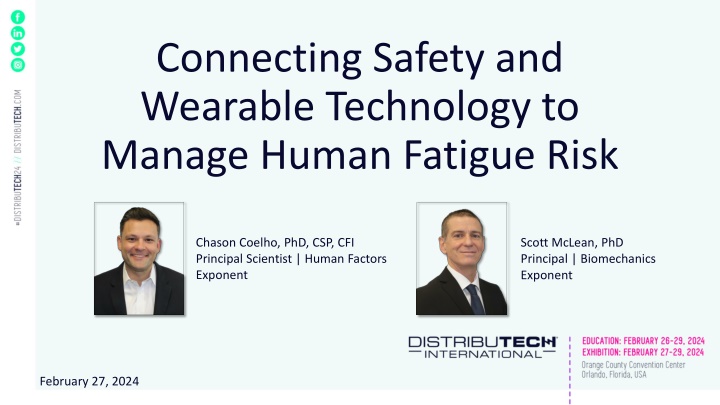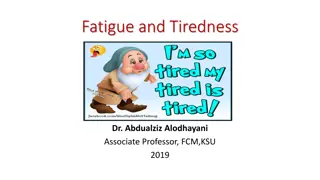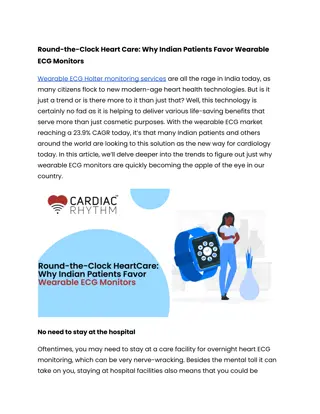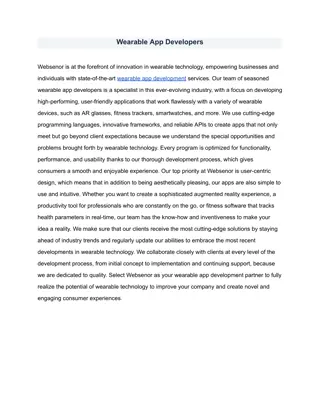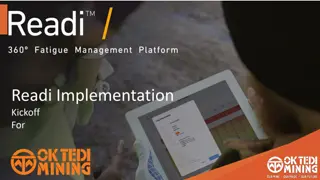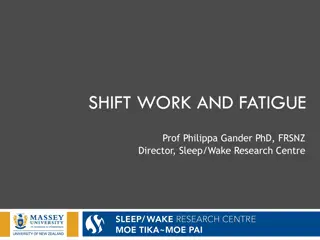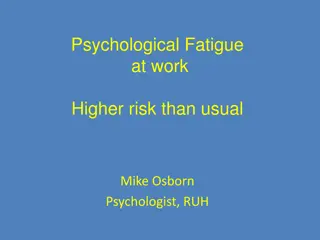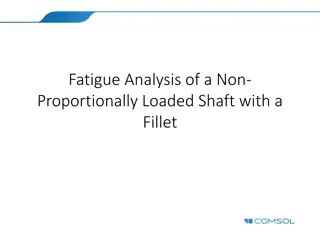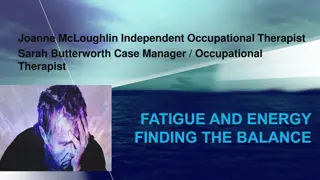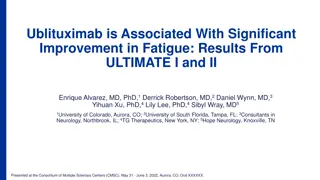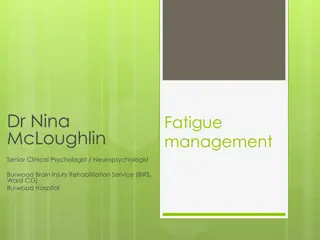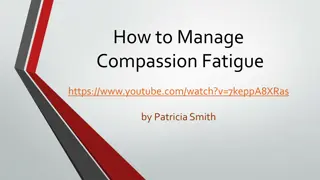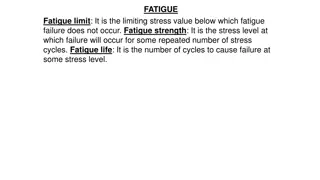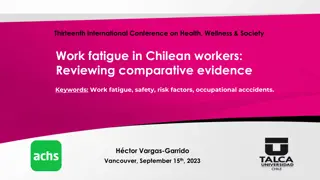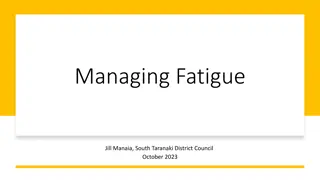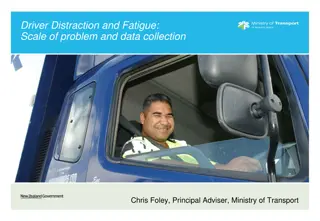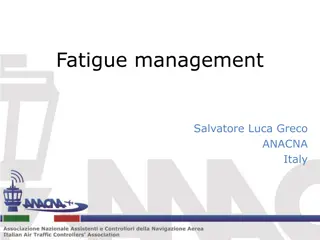Managing Human Fatigue Risk Through Safety and Wearable Technology
Explore the framework of human fatigue, the costs associated with fatigue-related accidents, performance impairments due to sleep deprivation, and the monetary losses incurred by businesses. Learn about solutions and systems integrating technology to monitor and manage human fatigue risk effectively.
Download Presentation

Please find below an Image/Link to download the presentation.
The content on the website is provided AS IS for your information and personal use only. It may not be sold, licensed, or shared on other websites without obtaining consent from the author.If you encounter any issues during the download, it is possible that the publisher has removed the file from their server.
You are allowed to download the files provided on this website for personal or commercial use, subject to the condition that they are used lawfully. All files are the property of their respective owners.
The content on the website is provided AS IS for your information and personal use only. It may not be sold, licensed, or shared on other websites without obtaining consent from the author.
E N D
Presentation Transcript
Connecting Safety and Wearable Technology to Manage Human Fatigue Risk Chason Coelho, PhD, CSP, CFI Principal Scientist | Human Factors Exponent Scott McLean, PhD Principal | Biomechanics Exponent February 27, 2024
Outline Human Fatigue Framework Costs Solutions Fatigue Risk Management Systems Technology Driven Performance, Health, and Wellness Monitoring Integration into Fatigue Risk Management Real-World Solution Example Conclusions
Framework Human fatigue is a state of reduced physical and mental functioning caused by exposure to fatigue hazards: sleep loss, circadian challenge, difficult task factors, or some combination thereof Fatigue risk can be defined by the probability that the fatigue hazard leads to an adverse incident and the potential severity of that incident
Costs of Fatigue: Catastrophic Accidents Three Mile Island / Chernobyl Both events began in early morning hours (0100-0600) Human error played critical roles BP Texas City Refinery Explosion 15 killed, 180 injured No fatigue prevention policies Excessive overtime Exxon Valdez Tankship Grounding Approximately 258,000 barrels of oil released Fatigue, workload, reduced crew size, and insufficient rest Space Shuttle Challenger Breakup Excessive shiftwork and overtime High operational tempo
Costs of Fatigue: Performance Impairment Restricted sleep (< 5 hours) makes people perform worse on various tasks than 90% of rested people Tasks studied include: Cognitive, motor, and mood Impairments include: Decreased vigilance Decreased attentional capacity Increased reaction time Cognitive distortions Emotional dysregulation
Costs of Fatigue: Monetary Loss ~ 360,000 fatal workplace accidents per year (ww) ~ 960,000 workers injured daily (ww) ~ $62 BN in direct U.S. compensation costs (2016) ~ $1 BN per week ~ 13% of injuries can be attributed to fatigue ~ 124,800 injuries per day (ww) Night workers are about three times more likely to be injured National Safety Council (NSC) estimates fatigue costs U.S. employers a total of approximately $136 BN per year
Costs of Fatigue: Adverse Workplace Outcomes Research suggests that non- fatigued workers: have fewer work accidents have lower disease burden use healthcare less miss less work do a better job when present make better decisions interact with others more positively (Barnes & Watson, 2019)
Solutions: Fatigue Risk Management Systems A Fatigue Risk Management System (FRMS) is a modern data-driven method of monitoring and managing fatigue-related safety risks, based on scientific principles and operational experience, to help ensure personnel work at adequate levels of alertness Data-driven: utilizes observations and fatigue-specific risk assessments Monitoring and managing: administrative control backed by company policy Scientific principles: fatigue risks and safeguards informed by science Operational experience: company- and operation-specific risks considered Overarching goal: reduce fatigue-related human error and increase in safety SCIENCE AND INDUSTRY INFO POLICY AND DOCUMENTATION FATIGUE RISK MANAGEMENT ASSURANCE PROMOTION
Solutions: Practical Fatigue Risk Assessment RISK CURRENT FATIGUE COUNTERMEASURES ACTION ITEM TO FURTHER MITIGATE OR CONTROL RISK TARGET DUE DATE ACTION ITEM OWNER ITEM WORK ACTIVITY FATIGUE HAZARD DATA SOURCE HAZARD SCENARIO CONSEQUENCE S L SxL RESULT Board operator suffers impaired situation awareness due to fatigue from excessive overtime, leading to undetected high level of rising flammable liquid in the raffinate splitting tower, material release, and explosion with subsequent fire Maximum allowable work period of 16 hours with only four hours of overtime at the end of a normal 12-hour shift Implement limitations on number of consecutive overtime days 1 Isomerization Unit Startup Excessive Overtime Incident Data Potential Injury to Employees and Public 5 3 15 STOP -- -- 0 OK 0 OK 0 OK 0 OK 0 OK A fatigue risk assessment modeled after the HAZOP addresses challenges: Human fatigue is common People are poor at self-assessing fatigue Many fatigue hazards are possible Hazards exist outside duty hours Hazards can vary with operations Fatigue expertise is uncommon within organizations 0 OK 0 OK
Solutions: SMS Integration An FRMS is simply a small SMS focused on fatigue hazards A Gap Analysis can identify current SMS elements to leverage Documentation Process Safety Information, Procedures, Mechanical Integrity Risk Management PHA, PSSR, MoC Assurance / Continuous Improvement Incident Investigation, Audits, Contractor Management Awareness / Competency Employee Participation, Training
Solutions: Technology-Driven Monitoring Wearables afford cost-effective and highly dynamic means to monitor worker performance, health, and wellness metrics in real-world environments
Solutions: Real-World Data Opportunities Real-world data insights support a broad range of product and user opportunities and an increased focus on worker performance, health, and wellness
Solutions: Performance, Health, and Wellness Workplace Fatigue Risk Evaluation and Mitigation Longitudinal Health and Wellness Evaluation General Employee Safety Monitoring Dynamic Ergonomics Optimization Existing technologies can be integrated into existing workplace strategies and frameworks to inform explicit worker performance, health, and wellness outcomes
Solutions: Wearables Already Making a Splash Existing niche and commercial wearable technologies are ideally suited to large-scale pain, wellness, and fatigue monitoring and management
Solutions: Wearable-Derived Metrics A broad range of physiological metrics can be used to monitor worker fatigue and recovery in operational settings
Solutions: Wearable Integration with FRMS Wearable implementation affords objective and actionable data-driven framework for short- and long-term FRMS strategies
Solutions: Real-World Example We supported the US Army through wearable tech health monitoring
Conclusions Human fatigue poses safety and cost risks Fatigue management can be challenging Risk-based methods are growingly popular An FRMS is the most comprehensive approach Practical fatigue risk assessment (FRA) is possible Existing safety management system elements can be leveraged Commercial off-the-shelf wearables can directly inform on fatigue risks Secure, confidential, and large-scale fatigue monitoring and assessment strategies, tailored to personnel requirements and cost restrictions, are now feasible Design and monitoring of explicit risk-reduction interventions based on objective data-driven outcomes are now easily within reach
References FRMS Implementation Guide for Operators, ICAO / IATA / IFALPA, 1st Ed., 2011. U.S. Chemical Safety and Hazard Investigation Board (CSB). Investigation Report, Refinery Explosion and Fire, 2007. Rogers, W. P., Armstrong, N. A., Acheson, D. C., Covert, E. E., Feynman, R. P., & Hotz, R. B. Report of the Presidential Commission on the Space Shuttle Challenger Accident. Washington, DC, 1986. Mitler, M. M., Carskadon, M. A., Czeisier, C. A., Dement, W. C., Dinges, D. F., & Graeber, R. C. Catastrophes, Sleep, and Public Policy: Consensus Report. Sleep, 11(1), 100-109, 1988. Pilcher, J. J. & Huffcutt, A. I. (1996). Effects of Sleep Deprivation on Performance: A Meta-analysis. Sleep, 19(4), 318-326. Barnes, C. M., & Watson, N. F. (2019). Why healthy sleep is good for business. Sleep medicine reviews, 47, 112-118.
Chason Coelho, PhD, CSP, CFI Principal Scientist | Human Factors Exponent Email: ccoelho@exponent.com Direct: 949-310-7449 Scott McLean, PhD Principal | Biomechanics Exponent Email: smclean@exponent.com Direct: 248-324-9119 The end: Thank you Questions?
